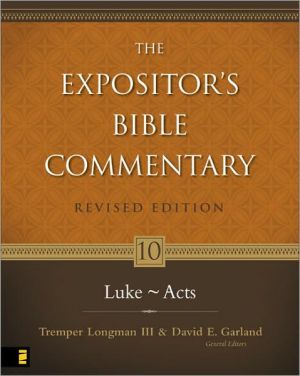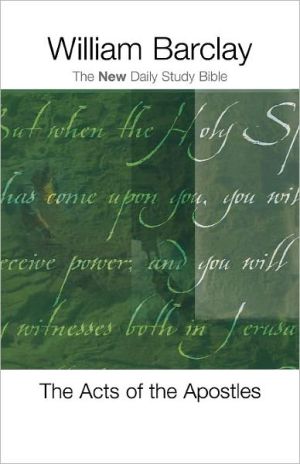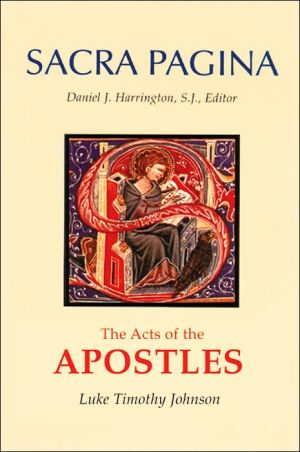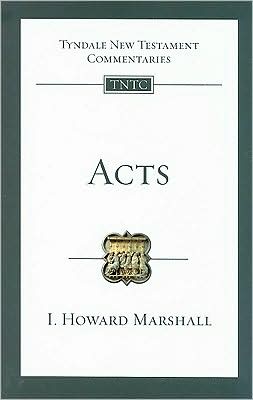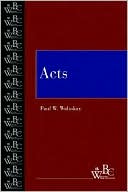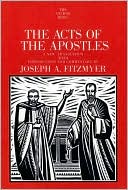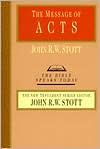The Expositor's Bible Commentary: Luke - Acts, Vol. 10
Continuing a Gold Medallion Award-winning legacy, this completely revised edition of The Expositor's Bible Commentary series puts world-class biblical scholarship in your hands. Based on the original twelve-volume set that has become a staple in college and seminary libraries and pastors' studies worldwide, this new thirteen-volume edition marshals the most current evangelical scholarship and resources.\ Of the fifty-six contributors, thirty of them are new. Reflecting the commentary's...
Search in google:
This is a revision of the Gold Medallion Award-winning commentary series. It is up to date in its discussion of theological and critical issues and thoroughly evangelical in its viewpoint.
Luke-Acts\ \ By Tremper Longman III David E. Garland \ Zondervan\ Copyright © 2007 Walter L. Liefeld and David W. Pao\ All right reserved.\ ISBN: 978-0-310-23500-2 \ \ \ Chapter One\ Text and Exposition\ I. Introduction (1:1-4)\ OVERVIEW\ The introduction to Luke is a long, carefully constructed sentence in the tradition of the finest historical works in Greek literature. It stands in contrast to the genealogical table of Matthew, the concise opening sentence of Mark, and the theological prologue of John. It was customary among the great Greek and Hellenistic historians, including the first-century Jewish writer Josephus, to explain and justify their works in a preface. Their objective was to assure the reader that they were capable and reliable and that they had done thorough research. While such a weighty introduction does not in itself guarantee the honesty of the writer, neither should its conventional form be dismissed as merely formal pretension.\ The classical literary style of the preface contrasts with the remainder of the gospel, in which Semitisms abound (cf. comments in introduction, sections 7 and 10; see Overview, 1:5-2:52).\ 1 Many have undertaken to draw up an account of the things that have been fulfilled among us, 2 just as they were handed down to us by those who from the first were eyewitnesses andservants of the word. 3 Therefore, since I myself have carefully investigated everything from the beginning, it seemed good also to me to write an orderly account for you, most excellent Theophilus, 4 so that you may know the certainty of the things you have been taught.\ COMMENTARY\ 1 The preface opens with the Greek word epeideper (GK 2077, untranslated in NIV; KJV, "forasmuch as"; NASB, "inasmuch as"), a classical word used only here in the NT but found in such major authors as Thucydides, Philo, and Josephus. It stands in stylistic contrast to the colloquial egeneto ("there was"), which in v.5 opens the narrative. The NIV omits epeideper for the sake of concise English style, adding "therefore" in v.3. This clarifies the meaning-that Luke's account was written after those of many others.\ "Many have undertaken" implies that by the time Luke wrote there was considerable interest in data about Jesus and his ministry. Luke does not say that he himself actually reproduced material from any of the existing accounts, though that could be assumed from this and subsequent evidence. The choice of the word "undertaken" (epecheireo, GK 2217) need not mean that earlier attempts to write gospel narratives had failed (cf. MM, 250-51; Vernon K. Robbins, "The Claims of the Prologues and Greco-Roman Rhetoric," in Jesus and the Heritage of Israel [ed. Moessner], 63-83). Obviously Luke would not be writing if there were no need for something further, but this does not necessarily reflect adversely on his predecessors. "To draw up an account" (anataxasthai diegesin, GK 421, 1456) means "to write a report or narrative, relating events in an orderly way" (cf.MM,38).The verbal form of diegesis (diegeomai, GK 1455) occurs in Luke (8:39; 9:10) and Acts (9:27; 12:17).\ "Fulfilled" is a better translation of peplerophoremenon (GK 4442) than "most surely believed" (KJV) in this context. The word and its cognate plerophoria (GK 4443) can be translated "full assurance" or "assurance" when their basic reference is to the confident attitude of a person (cf. Ro 4:21; 14:5; Col 2:2; Heb 6:11; 10:22). Otherwise, and especially with reference to things rather than people, the idea of accomplishment or completion is foremost. (See "discharge all the duties" and "fully proclaimed" in 2Ti 4:5, 17.) Further, if the accomplishment of God's purposes in the life and ministry of Jesus is one of Luke's themes, it is appropriate for the preface to reflect this.\ 2 "Just as they were handed down" stresses the validity of the tradition of Jesus' words and deeds. The same emphasis occurs in Paul, who was careful to pass on to others what had been "handed down" to him (1Co 11:23; 15:3; cf.O. Cullmann, The Early Church: Studies in Early Christian History and Theology [Philadelphia: Westminster, 1956], 59-75).\ Though the "eyewitnesses and servants" may have included some of the "many" (v.1), they are mostly to be distinguished from them because they were prior to them. Luke is establishing the validity of the information both he and his predecessors included in their narratives. Witnesses are important to Luke. While the concept of "witness" is not as prominent in Luke as in John (see esp. Jn 5:31-47), it is integral to Luke's historical and theological purposes.\ The words "from the first" (probably meaning from the early days of Jesus' ministry) are tied to the word "eyewitnesses" as closely as grammar permits-i.e., "the from-the-first witnesses" (hoi ap' arches autoptai). These were not passive observers but "servants of the word." Luke is probably referring primarily to the apostles, whose authority he upholds throughout Luke-Acts. In Acts 10:39-42, Peter speaks as one of those who were both witnesses and preachers.\ "Word" (logos, GK 3364) here means "the message of the gospel," especially as embodied in the words and deeds of Jesus. Ancient Greek writers often stressed the importance of matching one's words with appropriate deeds. In Acts 1:1, Luke combines the words "do" and "teach" when he describes Jesus' ministry. This is essential to the fulfillment mentioned in v.1.While all four gospels use the term logos (with particular significance in Jn 1:1, 14), Luke uses it surprisingly often. This is especially true in passages unique to Luke (see Gaston, 64, 76; Hawkins, 20, 43). In summary, v.2 makes a serious claim regarding Luke's careful historical research of witnesses and sources that has weighty implications for our estimation of the entire gospel.\ 3 The opening words in the Greek order are "it seemed good also to me" (edoxe kamoi). This establishes a balance and pattern of comparison between vv.1-2 and 3-4: "Many have undertaken" and "it seemed good also to me"; "to draw up an account" and "to write an orderly account"; "handed down to us" and "so that you may know."\ Luke now describes his own work of investigation and writing. The word "everything" may partially explain how his work differed from that of the "many" (v.1) and also from that of Mark-namely, in its greater comprehensiveness. "From the beginning" translates anothen (GK 540), which can mean, according to the context, either "above" or "again." Here in its relation to historical research it has a temporal sense. Theologically, Luke's concern for the "beginning" of the gospel surfaces here. Luke did his research "carefully" (akribos, GK 209; lit., "accurately") and wrote an "orderly" (kathexes, GK 2759) account. We cannot determine from this preface alone whether Luke is referring to a chronological or a thematic order. He does not specifically claim to have aimed at chronological sequence. Perhaps he may have followed an order found in his sources. If so, this could explain his occasional differences from Matthew and Mark. Or he may have rearranged his sources according to another pattern. Taken alone, the prologue is not conclusive as to these possibilities. In any event, Luke intended his claim of working in an orderly way to inspire confidence in his readers.\ The identity of "Theophilus" is unknown, though many suggestions have been made (cf. R. H. Anderson, "Theophilus: A Proposal," EvQ 69 [1997]: 195-215). The name ("friend of God") might be either a symbol or a substitute for the true name of Luke's addressee. Theophilus was, however, a proper name, and "most excellent" naturally suggests an actual person of some distinction. He may have been Luke's literary patron or publisher, after the custom of the times (cf. E. J. Goodspeed, "Som Greek Notes: I. Was Theophilus Luke's Publisher?" JBL 73 [1954]: 84).\ 4 Though it is not clear whether Theophilus was a believer, he had doubtless received some instructions in the faith. The genitive plural (logon) of logos ("word," GK 3364) is here translated in the NIV as "things"-a legitimate extended use. Theophilus has learned of both the words and deeds of Jesus. "Taught" (katechethes, GK 2994) may refer to formal church teaching (Gal 6:6), but does not necessarily do so. For some reason Theophilus needed assurance, or "certainty" (asphaleia, GK 854), as to the truth of the things taught to him. Possibly he was troubled by denials of the resurrection and other historical foundations of the faith that gnostic speculation was challenging. Such are not to be countered by mere speculation but by the factual narrative Luke is about to write. His book will set forth evidences and purposes ancillary to the one he has stated in this preface.\ According to the prologue, Luke's purpose in writing was to assure Theophilus of the "certainty" of the gospel tradition. His gospel can still fulfill this purpose, without excluding other purposes for Luke-Acts (cf. section 5, "Purpose," in the introduction).\ II. Birth and Childhood Narratives (1:5-2:52)\ OVERVIEW\ This narrative introduces a section in Luke unparalleled in the other gospels (see introduction for critical and stylistic issues). Its distinctive characteristics include (1) an atmosphere reminiscent of the OT, with a Semitic grammatical and stylistic cast; (2) an alternating focus on John the Baptist and Jesus; (3) the awesomeness of heavenly beings appearing to humans; and (4) a note of joy, especially as heard in four songs: Mary's (1:46-55), Zechariah's (1:68-79), the angels' (2:14), and Simeon's (2:29-32).\ (1) The Semitic style fits the religious and historical connection Luke is establishing between the OT and NT periods. Luke does not use the fulfillment formulas Matthew uses but shows that OT promises stand behind the events he describes. He does this by giving his style and vocabulary a Septuagintal flavor. He also takes pains to ground the Christian message in Jerusalem and in its temple, the cultic center of Israel.\ (2) To make this connection with the OT, Luke also uses a pattern of alternation in which attention shifts back and forth between John the Baptist and Jesus. Far from being the result of a confusion of sources, as is sometimes supposed, this alternation is a literary device to focus attention successively on each person (cf. G. N. Stanton, Jesus of Nazareth in New Testament Preaching [SNTSMS 27; Cambridge: Cambridge Univ. Press, 1974], 55-56). Luke clearly identifies John as a successor to the OT prophets. Through his alternating presentations, Luke links John and Jesus, whom Luke apparently also identifies as a prophet (cf. Minear, 95-96). Since he also sees in Jesus far more than a prophet, Luke's device of alternation goes beyond comparison to contrast, with Jesus presented as "Son of the Most High" and messianic Deliverer (1:32-33, 69, 76; 2:11, 30). This same point is expressed through the structuring of the material, where the parallelism between John the Baptist and Jesus is "broken" by two episodes that highlight the superiority of Jesus (1:39-56; 2:41-52). The structure of the section then is (1a) the announcement of John's coming birth; (1b) the announcement of Jesus' coming birth; (2) Elizabeth's blessing of Mary, and Mary's praise to God; (3a) John's birth; (3b) Jesus' birth, which is acclaimed by angels in heaven and by saintly Jews in the temple; and (4) Jesus at the temple, where he reveals his wisdom and knowledge (cf. Karl Kuhn, "The Point of Step-Parallelism in Luke 1-2," NTS 47 [2001]: 38-49).\ (3) The appearance of angels is likewise appropriate for an account that teaches that God has acted decisively in the history of his people to accomplish their salvation. Some reject this supernatural activity, attempting to explain the narratives as an accretion of legends. To do so deprives the event of an effective cause. Actually, the appearance of an angel is no more remarkable than the incarnation itself.\ (4) The theme of joy finds expression not only in the songs but also in the tone of the whole passage. The gospel is always "good news of great joy" (2:10). Moreover, the passage realistically includes a reminder both of the pain of sin and of the cost of our deliverance, as Simeon's allusion to the ultimate death of Mary's son (2:35) shows.\ Another pattern of themes may be seen in the repetition of the phrase "Most High": (1) Jesus is the "Son of the Most High" (1:32); (2) Mary's conception by the Holy Spirit is said to be by the "power of the Most High" (1:35); and (3) John is called a "prophet of the Most High" (1:76; cf. H.H. Oliver, "The Lucan Birth Stories and the Purpose of Luke-Acts," NTS 10 [1963-64]: 215-26).\ While the phrases just outlined do not occur in close sequence, they should probably be taken together as relating to three major themes in Luke's gospel: (1) John is the final prophet of the OT period, the forerunner of the Messiah, and the first proclaimer of the kingdom; (2) Jesus is the unique Son of God, the true eschatological prophet and Messiah; and (3) the Holy Spirit's ministry both validates and empowers the ministry of Jesus. (The Holy Spirit is mentioned frequently in this section; see 1:15, 35, 41, 67, 80 [TNIV text note]; 2:25-27.) Other themes prominent in Luke occur in these opening narratives and will be noted in the commentary section.\ A. Anticipation of Two Births (1:5-56)\ 1. The Birth of John the Baptist Foretold (1:5-25)\ 5 In the time of Herod king of Judea there was a priest named Zechariah, who belonged to the priestly division of Abijah; his wife Elizabeth was also a descendant of Aaron. 6 Both of them were upright in the sight of God, observing all the Lord's commandments and regulations blamelessly. 7 But they had no children, because Elizabeth was barren; and they were both well along in years.\ 8 Once when Zechariah's division was on duty and he was serving as priest before God, 9 he was chosen by lot, according to the custom of the priesthood, to go into the temple of the Lord and burn incense. 10 And when the time for the burning of incense came, all the assembled worshipers were praying outside.\ 11 Then an angel of the Lord appeared to him, standing at the right side of the altar of incense. 12 When Zechariah saw him, he was startled and was gripped with fear. 13 But the angel said to him: "Do not be afraid, Zechariah; your prayer has been heard. Your wife Elizabeth will bear you a son, and you are to give him the name John. 14 He will be a joy and delight to you, and many will rejoice because of his birth, 15 for he will be great in the sight of the Lord. He is never to take wine or other fermented drink, and he will be filled with the Holy Spirit even from birth. 16 Many of the people of Israel will he bring back to the Lord their God. 17 And he will go on before the Lord, in the spirit and power of Elijah, to turn the hearts of the fathers to their children and the disobedient to the wisdom of the righteous-to make ready a people prepared for the Lord."\ 18 Zechariah asked the angel, "How can I be sure of this? I am an old man and my wife is well along in years."\ 19 The angel answered, "I am Gabriel. I stand in the presence of God, and I have been sent to speak to you and to tell you this good news. 20 And now you will be silent and not able to speak until the day this happens, because you did not believe my words, which will come true at their proper time."\ 21 Meanwhile, the people were waiting for Zechariah and wondering why he stayed so long in the temple. 22 When he came out, he could not speak to them. They realized he had seen a vision in the temple, for he kept making signs to them but remained unable to speak.\ 23 When his time of service was completed, he returned home. 24 After this his wife Elizabeth became pregnant and for five months remained in seclusion. 25 "The Lord has done this for me," she said. "In these days he has shown his favor and taken away my disgrace among the people."\ COMMENTARY\ 5 As already mentioned, the style of this section is different from the classical style of vv.1-4. Likewise, the method of dating differs from that used later in 3:1, where Luke is interested in establishing a more precise point of historical reference. In this verse, his only concern is to locate the events in the reign of Herod (king of Judea, 37-4 BC).\ (Continues...)\ \ \ \ \ Excerpted from Luke-Acts by Tremper Longman III David E. Garland Copyright © 2007 by Walter L. Liefeld and David W. Pao. Excerpted by permission.\ All rights reserved. No part of this excerpt may be reproduced or reprinted without permission in writing from the publisher.\ Excerpts are provided by Dial-A-Book Inc. solely for the personal use of visitors to this web site. \ \
Contents Contributors to Volume Ten.....................6Preface........................................7Abbreviations..................................9Luke...........................................19John...........................................357Acts...........................................663
